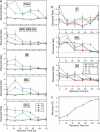Ionic control of ocular growth and refractive change
- PMID: 17023537
- PMCID: PMC1622878
- DOI: 10.1073/pnas.0607241103
Ionic control of ocular growth and refractive change
Abstract
The physiological mechanisms underlying the abnormal vitreal and ocular growth and myopic refractive errors induced under conditions of visual form deprivation in many animal species, including humans, are unknown. This study demonstrates, using energy dispersive x-ray microanalysis, a systematic pattern of changes in the elemental distribution of K, Na, and Cl across the entire retina in experimental form deprivation myopia and in the 5 days required for refractive normalization after occluder removal. In our report we link the ionic environment associated with physiological activity of the retina under a translucent occluder to refractive change and describe large but reversible environmentally driven increases in potassium, sodium, and chloride abundances in the neural retina. Our results are consistent with the notion of ionically driven fluid movements as the vector underlying the myopic increase in ocular size. New treatments for myopia, which currently affects nearly half of the human population, may result.
Conflict of interest statement
The authors declare no conflict of interest.
Figures



References
-
- Wallman J, Winawer J. Neuron. 2004;43:447–468. - PubMed
-
- Wallman J, Turkel J, Trachtman J. Science. 1978;201:1249–1251. - PubMed
-
- Liang H, Crewther SG, Crewther DP, Junghans BM. Invest Ophthalmol Vis Sci. 2004;45:2463–2474. - PubMed
-
- Liang H, Crewther SG, Crewther DP, Pirie B. Aust NZ J Ophthalmol. 1996;24:41–44. - PubMed
Publication types
MeSH terms
Substances
LinkOut - more resources
Full Text Sources
Medical

